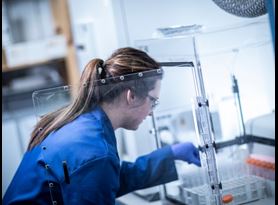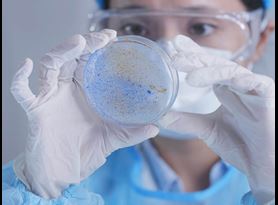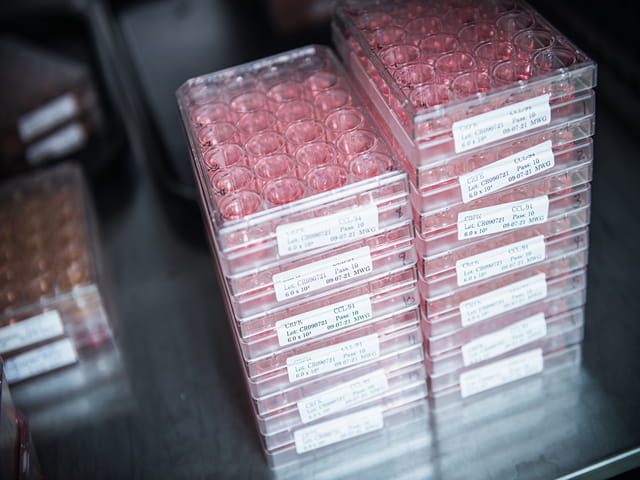
Talk to an expert
+1 888 786 7555European countries and other jurisdictions require biocidal products, which are regulated by the European Chemical Agency (ECHA), be evaluated for virucidal activity using European Standards. With deep expertise in testing to EN standards for virucidal activity, leading organizations partner with Element for virucidal EN testing.
Virucidal efficacy testing for products regulated by the ECHA typically follow a tiered approach. Generally, this is done in a two-step manner, using a suspension based method and a carrier based method. The in-depth requirements for testing can be found in the Biocidal Products Regulation (BPR). The efficacy data generated supports the specific antiviral activity of the product, which is required for registration of a virucidal disinfectant. Element offers virucidal EN testing to a range of established methods, and custom EN methods or other EN methods may be considered or tailored to meet the distinct testing needs for a specific product.
If you don't see the method you're interested in, contact us today to explore alternative methods to meet your EN testing needs. With decades of experience in microbiology and virology, our team can develop custom protocols and test to a multitude of established methods to meet your specific needs.
Suspension based testing
BS EN 14476 - Chemical Disinfectants and Antiseptics - Quantitative Suspension Test for the Evaluation of Virucidal Activity in the Medical Area 0 Test Method and Requirements (Phase 2 / Step 1)
When products are tested to this method, a suspension of virus is added to a solution of interfering substances. A prepared test solution of a product is added to the suspension of virus in interfering substances. The mixture is maintained at the requested temperature for the requested exposure time. At the end of the exposure time, aliquots are taken and the virucidal activity against the test virus in this portion is immediately neutralized or suppressed by dilution in ice-cold test medium and serial dilutions are performed. The dilutions are then assayed for viral infectivity by an assay method specific for the test virus. Appropriate controls are also performed. Reduction of virus infectivity is calculated from differences of log virus titers and after treatment with the product.
Typical viruses tested include both non-enveloped and enveloped viruses: Poliovirus type 1 (LSc 2ab), Adenovirus type 5 (strain Adenoid 75, ATCC VR-5), Murine Norovirus (strain S99 Berlin), Murine Parvovirus/Minute Virus of Mice (strain Crawford, ATCC VR-1346), Modified vaccinia virus (Ankara, ATCC VR-1508 or Elstree ATCC VR-1549). Other viruses may also be tested as applicable. It is important to note the test substance must demonstrate a 4 log reduction in virus for registration.
BS EN 14675 - Chemical Disinfectants and Antiseptics - Quantitative Suspension Test for the Evaluation of Virucidal Activity of Chemical Disinfectants and Antiseptics Used in the Veterinary Area - Test Method and Requirements (Phase 2, Step 1)
In this method, a suspension of virus (veterinary strain) is added to a solution of interfering substances. A prepared test solution of a product is added to the suspension of virus in interfering substances. The mixture is maintained at the requested temperature for the requested exposure time. At the end of the exposure time, aliquots are taken and the virucidal activity against the test virus in this portion is immediately neutralized or suppressed by dilution in ice-cold test medium and serial dilutions are performed. The dilutions are then assayed for viral infectivity by an assay method specific for the test virus. Appropriate controls are also performed. Reduction of virus infectivity is calculated from differences of log virus titers before and after treatment with the product.
Typical virus tested is Bovine Enterovirus type 1 (Enteric Cytopathogenic Bovine Orphan virus-ECBO, ATCC VR-248). Other viruses may also be tested as applicable. The test substance must demonstrate a 4 log reduction in virus for registration.
Hard surface testing
BS EN 16777- Chemical Disinfectants and Antiseptics - Quantitative Non-Porous Surface Test without Mechanical Action for the Evaluation of Virucidal Activity of Chemical Disinfectants Used in the Medical Area - Test Method and Requirements (Phase 2 / Step 2)
A suspension of virus is added to a solution of interfering substances and is inoculated onto a 2cm diameter test carrier and dried. A prepared test solution of a product is added to the dried virus film. The carrier is maintained at the requested temperature for the requested exposure time. At the end of the exposure time, the carrier is transferred to a neutralizer and serial dilutions are performed. The dilutions are then assayed for viral infectivity by an assay method specific for the test virus. Appropriate controls are also performed. Reduction of virus infectivity is calculated from differences of log virus titers before and after treatment with the product.
Typical viruses tested include both non-enveloped and enveloped viruses: Adenovirus type 5 (strain Adenoid 75, ATCC VR-5), Murine Norovirus (strain S99 Berlin), Modified vaccinia virus (Ankara, ATCC VR-1508 or Elstree ATCC VR-1549). Other viruses may also be tested as applicable. The test substance must demonstrate a 4 log reduction in virus for registration.
The Element advantage
Element has been supporting the successful registration of disinfectants with ECHA for more than fifteen years. Leading developers, manufacturers, and marketers of products with virucidal efficacy claims trust our responsive teams to generate needed data to comply with regulatory requirements that meet EN standards. Partner with Element for testing to established methods, as well as for customized protocols tailored to meet your specific needs.
For more information about Element's EN virucidal testing services, contact us today.
More from Element

Microbiology and Toxicity Testing
Element’s experts keep abreast of the latest analytical methods, providing a vast array of tests that determine the microbiology and toxicity levels in soils and liquids according to customers’ specifications and government regulations.

Client Portal
Secure 24/7 access to your test result information, which you can download directly to your information management system.

SARS-CoV-2 Disinfectant Efficacy Testing
Element is at the forefront of disinfectant efficacy testing against SARS-CoV-2 and its variants, which are the causative agents of COVID-19.

About Element Eagan
Element Eagan is the premier contract antimicrobial testing laboratory and expert partner to the developers, manufacturers and users of antimicrobial pesticide and biocide products. We have more than 30 years of experience generating GLP-compliant data.
